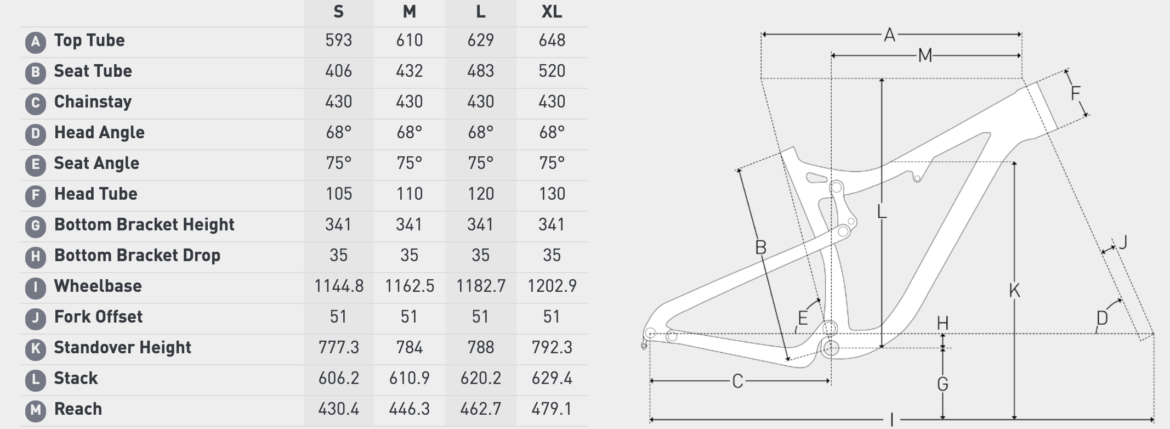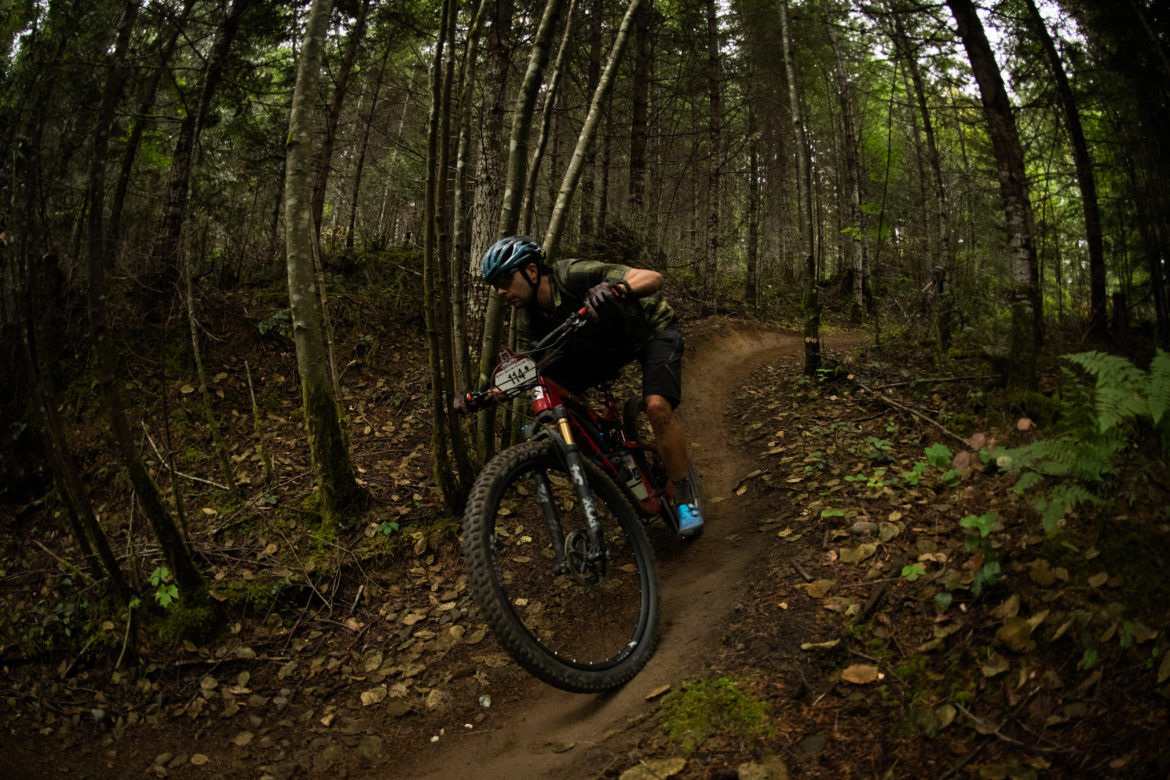
When I found out that I’d be racing the BC Bike Race, it made sense to find a bike to haul up to the Northwest which I could review, and would suit the race and the style of riding on the BCBR stages.
There is no shortage of these new-age, cross-country brawlers on the market, but something told me that the Fezzari Signal Peak would be worth checking out. Fezzari, based out of Utah, is a direct-to-consumer bike brand that has been gaining some serious traction lately. Bikes are flying off their shelves, and their sales have gone through the roof.
Media reviews have been rave and the consumers I’ve met that have a Fezzari are pretty dang happy with them. There were still a lot of people I met out on the trail who hadn’t heard of the brand and who were really interested in learning about Fezzari.
Surely, the racey red grabbed the attention of many, just like a red Italian sports car would, cruising down the avenue. The aggressive cuts and lines on the frame don’t scream out “XC nerd” either, likewise, helping the cause.
About the bike

Fezzari made the Signal Peak to be a modern cross-country bike, and really the cross-over means that it’s suitable as a daily driver for a lot of folks.
The Signal Peak frame comes in carbon only, with a starting price of $2,100 for a frameset, $3,000 for a build with SRAM NX Eagle, and peaking at $7,999 for the team-level build.
The new Pro build kit includes everything I tested, like the Fox Transfer dropper post, Fox shock, and Fox Float 34, all with Kashima, but now with ENVE handlebars, and a choice between ENVE M525 or M630 wheels, and Shimano XTR or SRAM AXS drivetrains, for $7,600. Although the Industry Nine hubs included at this price point are the 101s, buyers can upgrade and get the Hydra hubs, with AXS and all the other stuff mentioned above for $8,000.
Now, closing in on $8,000, one might not think that they’d be saving a lot of money by going with a direct-to-them Fezzari, but let’s take a look at a few comparable dealer-only bikes.

A Yeti SB100 T3 build with the same Fox Factory Kashima coated fork, shock, and dropper post, and DT Swiss XRC carbon wheels rings in at $9,300. It’d be $10,400 if buyers elected a SRAM AXS add-on and the carbon wheels. The Fezzari can do it for $7,600.
A Pivot Mach 4SL build, also with Fox Factory suspension, DT Swiss carbon wheels, and a 12-speed Shimano XTR groupset costs $8,500, still about a thousand dollars more than the Signal Peak. With a SRAM AXS kit, the Pivot comes in around $9,400.
These aren’t perfect comparisons, but it is easy to see that Fezzari can offer more bang for the buck than the standard dealer-only brand, although some might not be ready to cross that line.
Specs

- Cross-country/trail bike with 120mm F/R travel
- 75° seat angle
- 68° head angle
- Fits two bottles inside frame
- Tetra-link suspension
- GA-link to swap from 29″/27.5+
- Sizes S-XL
- Price: $2,100-$7,600 (Tested: $7,600)
- Weight: 27.2lbs (M) w/o pedals

Ride impressions

The Fezzari took some getting used to, and I’ll have to admit, I wasn’t an immediate fan. The Signal Peak’s reach closes in on 450mm, and it felt very long for me, even though the Salsa Spearfish I was transitioning from had very similar geometry.
While I adjusted to the Signal Peak, there were a few things that I did immediately notice. For starters, it’s one of the most quiet bikes I have ridden. There isn’t any noticeable ting-tang of chain slap. The internal cable routing also keeps brake and gear cables snug and rattle-free. Really, the only thing I could hear was the squishing of the Fox dampers, as even the hub is pretty silent. Sure, every now and then a hub that sounds like a rattlesnake on Red Bull is great, but there’s something to be said about a quiet bike.
Climbing on the Signal Peak is very comfortable. The seat angle sits up at a steep 75°, while a lot of other cross-country bikes have kept their seat angles fairly relaxed. I was afraid this would leave me in a position that’s too “square” but it felt great. On steep climbs, I could still hunch myself over the top tube to get my weight nice and low, thanks to the long reach.

The Tetra-Link suspension offers a solid pedaling platform with noticeable anti-squat. It’s probably not as solid as a DW-link or Switch Infinity, like the two quasi-competitors mentioned above, but overall, the Signal Peak’s suspension is very impressive.
On descents, the suspension manages great low-speed performance over bumps and while braking, and it feels nice and cush on larger hits and drops, providing stability and confidence.
Over the course of BC Bike Race, after summiting long, steep, and sometimes very technical climbs, we were treated to downhills that were just as good: steep, rocky, bumpy, and occasionally jumpy. I had the Signal Peak in the air more than I previously would have thought a 120mm bike should be, and the trail bike never shook my confidence on rough landings.

The 68° head tube angle is also deceiving. While seeing a number in the high 60s doesn’t seem like it would perform that well down steep trails, the Signal Peak never felt skittish. Again, this is possibly due to the long reach, and the fact that it keeps the rider’s weight well behind the bars.
The only downside I noticed about the long front triangle was that I had to consciously shift my weight forward more than usual around corners to keep traction on the front end.
Component check

My Signal Peak test bike was specced with the nicest of nice components, including Fox Factory suspension, with Kashima, even on the dropper post.
I was skeptical that the Kashima-coated dropper post would offer anything special from the non-Kashima Fox Transfer, but it is noticeably smoother and without any sticky feeling.
I was most curious with how the new Shimano 12-speed XTR would hold up over a week of racing. With the weeklong race covering 200-miles over technical BC terrain, in and out of water, mud, loam, and dust, surely, I’d run into something, right?

Even sopped in mud and grime, the new Shimano XTR never skipped a beat or a gear and stayed crisp during my whole test period. As a side note, I probably exceeded 400 miles on this bike during my time with it, more than any other test bike, and frame and components were as good as new in the end.
The Shimano XTR brakes felt consistent the entire time, and the modulation and power never wavered.
The only component issue I ran into turned out to be the DT Swiss freehub. There was a creaking from the rear end that came and went during my time with the bike that I could not diagnose. I checked the bottom bracket, cassette, pivot bolts, and just about everything else. The noise occurred when I was pedaling, usually in a lower gear. After every wash, the creaking would go away for a period. After Fezzari looked the bike over when it arrived home, they chalked it up to a little bit of play in the freehub, which I also noticed during my look-over.
Final word

I have to admit that the Signal Peak impressed me in a number of ways. There is a considerable amount of savings with the Fezzari on a number of build kits, compared to more costly carbon “super bikes,” and the Signal Peak doesn’t feel like a lesser performer. The Signal Peak remained a premium and reliable, aggressive XC bike during my entire time with it, which saw more abuse than any other review bike I have tested yet. That reliability paired with the bike’s capability left a lasting impression on me.
- MSRP: $2,100-$7,600
- Buy direct from Fezzari





















4 Comments
Sep 20, 2019
Sep 16, 2019
Funny story: I was in a trailhead lot this past spring, sitting in my car with the windows open, and overheard a conversation between a guy who appeared to be fairly new to mountain biking and his friend, who was clearly a more experienced rider, but who also seemed like one of those guys always out to impress someone with what they "know." Anyway, the first guy says, "Huh, I've never heard of that bike company before." To which the second guy replies, "Oh, yeah. Fezzari. They're an Italian bike maker. He must've imported that bike." LOL
Nov 22, 2019
Nov 22, 2019